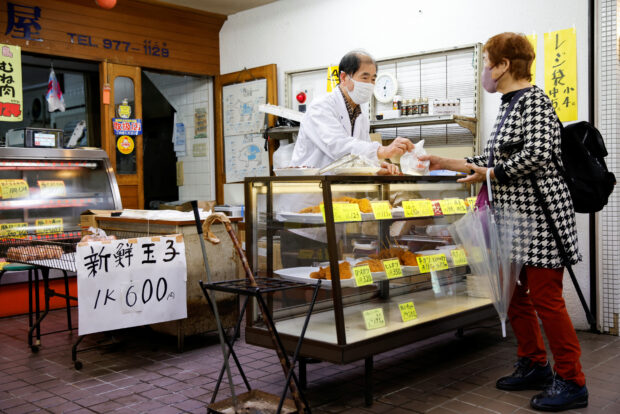Japan’s inflation stays above BOJ target, key gauge hits 42-year high

A customer buys food at a shop selling cooked food at a market in Tokyo, Japan, March 24, 2023. REUTERS/Androniki Christodoulou
TOKYO – Japan’s core consumer inflation exceeded forecasts in May and an index excluding fuel costs rose at the fastest annual pace in 42 years, highlighting broadening price pressure that will keep the central bank under pressure to phase out its massive stimulus.
The increase was driven by steady price hikes for food and daily necessities, suggesting a drag on consumption from the rising cost of living facing households, analysts say.
The nationwide core consumer price index (CPI), which excludes fresh food but includes energy items, rose 3.2 percent in May from a year earlier, data showed on Friday, slowing from 3.4 percent in April but exceeding market forecasts for a 3.1- percent gain.
Core consumer inflation has now stayed above the central bank’s 2 percent target for 14 straight months, casting doubt on its view the recent cost-driven inflation will prove temporary.
“As the pass-through of rising costs runs its course, core consumer inflation will peak around summer,” said Ryosuke Katagi, market economist at Mizuho Securities.
“But companies may keep passing on costs for longer than expected. Risks to inflation are skewed to the upside.”
The so-called “core-core” index that strips away the effects of both fresh food and fuel – closely watched by the Bank of Japan (BOJ) as a key barometer of domestic demand-driven price trends – rose 4.3 percent in May, accelerating from a 4.1-percent gain in April and marking the biggest increase since June 1981.
While energy costs fell 8.2 percent in May year-on-year due to the effect of government subsidies, food inflation accelerated to 9.2 percent last month from 9 percent in April as prices rose for goods ranging from fried chicken, hamburgers to chocolates.
Hotel room charges also jumped 9.2 percent in May, faster than a 8.1 percent increase in April, the data showed, a sign robust tourism demand was allowing operators to charge higher fees.
Policy shift distant?
Services prices rose 1.7 percent year-on-year in May, slower than a 4.7- percent increase in goods prices but steady from April in a sign higher wages may start to feed into services inflation.
Analysts polled by Reuters expect core CPI in Japan’s capital Tokyo, seen as a leading indicator of nationwide trends, to rise 3.3 percent year-on-year in June after a 3.2 percent gain in May.
The data heightens the chance the BOJ will revise up its price forecasts at its next quarterly review in July, though an end to ultra-low interest rates is unlikely, analysts say.
“Although price pressures are broadening, inflation nevertheless remains overwhelmingly supply-driven,” said Stefan Angrick, senior economist at Moody’s Analytics.
“With an economy that is still smaller than before the pandemic, policy tweaks remain some way off.”
Some market players expect the BOJ to tweak its yield control policy as soon as in July to address its side-effects such as distortions caused in the bond market.
BOJ Governor Kazuo Ueda has stressed the need to keep loose policy until inflation is sustainably around 2 percent and accompanied by wage hikes. He has also said core consumer inflation will slow back below 2 percent by September or October, though sustained price rises have put that view into some doubt.
In its last projections made in April, the BOJ expected core consumer inflation to hit 1.8 percent in the current fiscal year ending in March 2024. That is much lower than a 2.6% increase projected in a Reuters poll taken in May.
READ: Japan upgrades Q1 GDP on solid capex
READ: Japan’s consumer inflation stays above central bank target as price hikes broaden
READ: BOJ keeps ultra-low rates, focus shifts to Ueda’s inflation views
Read Next
Subscribe to INQUIRER PLUS to get access to The Philippine Daily Inquirer & other 70+ titles, share up to 5 gadgets, listen to the news, download as early as 4am & share articles on social media. Call 896 6000.
For feedback, complaints, or inquiries, contact us.
For all the latest Business News Click Here
For the latest news and updates, follow us on Google News.



